Guitar
The Les Paul Junior TV finish is one of the classic vintage guitar finishes and also one of that has been re-interpreted in many ways on various reissues over the years. The worst interpretation in my opinion was Gibson's early 90's version, which was an opaque mustard color, with a slight greenish tinge.
In reality, the TV finish, which was also applied to Les Paul Specials and even a handful of SG-shaped Les Paul Juniors from the 60s - was similar to the translucent "blonde" finish applied to Fender Telecasters during the the 50s, 60s and 70s. Over time, depending on the thickness of the clear coat and the opacity of the color coat, TV finishes appear to yellow to different degrees - with some taking on a light tan color (the so-called "wheat" finish) and some turning a creamy yellow color.
A client brought me his 1990 Les Paul TV Junior for a refinish - initially precipitated by damage to the top of the guitar ( a number of deep dings from something falling on the guitar) - but also as an opportunity for him to replace the "mustard" finish with a 50's style TV finish.
After a bit of discussion and research by both of us, it was decided that the goal would be to show off the grain of the mahogany as much as possible THROUGH the TV finish - basically applying what was close to a 1956-style TV finish, as opposed to the more opaque 1959 style TV finish more commonly seen on double-cut Les Paul Juniors.
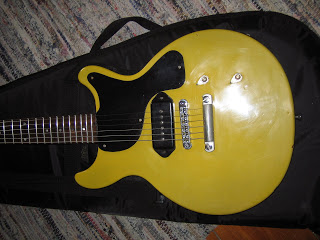
The dings in the top are visible in this view if you look closely.
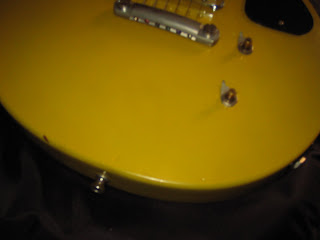
The first step was to mask off the headstock and fretboard and strip the entire guitar down to bare wood. The finish came off fairly easily, with very little finish left in the grain. The mahogany of the guitar displayed a very tight grain, meaning it would be fairly challenging to really make the grain stand out through the TV finish.
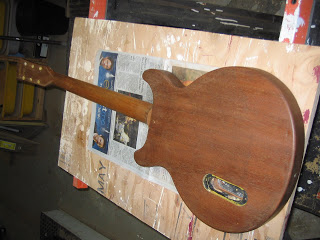
Note the shadow of the pickguard on the top of the guitar - illustrating that the finish wasn't truly opaque - enough light penetrated to change color of the wood that wasn't covered by the guard!
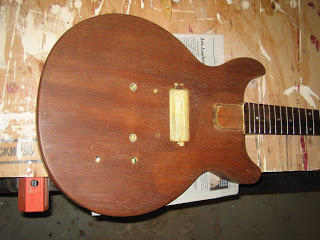
Once the wood was bare - I used my dent steaming technique to remove roughly half a dozen small and medium dings on the face and edge of the body.

To emphasize the grain, I decided to use a technique described on the ReRanch website. This technique called for a thin fairly opaque coat of "blonde" nitro to be sprayed on the bare wood - more as a wash than a finish, such that the pores in the mahogany are not filled in with the finish.
Then a dark grain filler is applied OVER the light colored base, with the idea being that the filled grain will contrast strongly with the coated mahogany. This approach may very well duplicate the "limed mahogany" approach that's mentioned in reference to the TV finish. The challenge is in getting the filler ONLY in the pores - and removing the excess without removing the thin "liming" coat.
The finish that was used was based on the tint I used for a 1968 Telecaster refinish, but with some more amber and a little yellow dye added. This was then cut with clear lacquer and thinned down more than I would for a typical finish coat. A nice even light coat was sprayed on the entire instrument.


As you can see in this close-up, the grain was NOT filled by the wash coat.
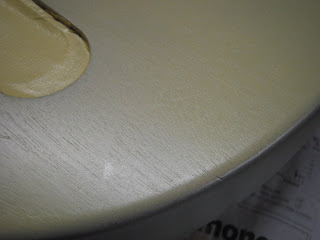
Now came the grain filling operation - which is always messy. As a first step, a good solid coat of walnut colored, oil-base filler was wiped onto the guitar -working one surface at a time.
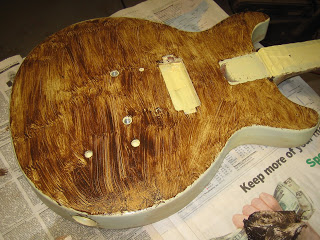
A scraper (and old credit card in this case) was drawn ACROSS the grain to remove the excess filler while leaving the pores of the wood filled.
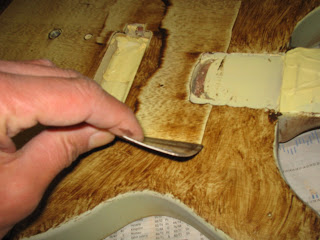
There was still a lot of extra filler on the surface of the wood after this scraping, but the filler was allowed to dry for about an hour before the next removal step was carried out, using a soft cloth that was just a little damp with paint thinner (which will not attack the nitro wash coat). A very light touch is required for this step and work ACROSS the grain - take off less rather than more, otherwise you WILL pull the filler out of the pores.
After the guitar sat for another hour, I gently rubbed the surface - across the grain again - with a dry cloth to polish off some more of the excess filler. The picture below is the guitar after this step.
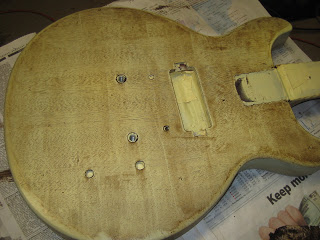
A few days later, I used 400 grit and 600 grit sandpaper - and a VERY light touch - to remove the rest of the extra filler and even out the color of the guitar.


The grain is well emphasized on the front and back of the body, but the tight grain of the neck isn't as emphasized, because it simply has smaller pores.

The next step will be to clear coat the guitar - and then slowly build up a translucent "TV" finish on top of this base.
- 1966 Fender Jazzmaster: Aged Olympic White
< A fairly straightforward project here - a 1966 Fender Jazzmaster body that had been poorly refinished over the years and that the owner wanted to do in an aged Olympic White finish. The original Olympic White is a color thats seldom seen - its a bright...
- 1968 Fender Telecaster: Blonde Refinish & Repair - Updated!
This project belongs to a customer who found this 1968 Telecaster that had been through a lot of changes but offered the basis for an excellent restoration. The guitar body had been stripped and routed for humbuckers. In addition, the body had some serious...
- G&l L1000 Bass - Partial Refinish
Another project that has recently come my way - an early 80s G&L L-1000 bass with a mahogany body and a transparent brown or mocha finish - that has suffered from some sort of finish deterioration on the front face only. The pits in the finish actually...
- 1968 Gibson Eb-3 Project
Yet another project - one of my favorite types of instruments to work on - maybe because there are so many abused examples out there ? This is a late 60's Gibson EB-3 bass - structurally very similar to a 68/69 EB-0 I recently finished and sold on...
- 1960s Guild Starfire Bass Refinish
The other recent project that came my way is a stripped 1968 Guild Starfire bass, which a customer in New York asked me to refinish. We are still pondering exactly what to do with the bass - his preference is to get all remnants of the old finish off...
Guitar
1990 Les Paul Junior TV, Vintage style refinish
The Les Paul Junior TV finish is one of the classic vintage guitar finishes and also one of that has been re-interpreted in many ways on various reissues over the years. The worst interpretation in my opinion was Gibson's early 90's version, which was an opaque mustard color, with a slight greenish tinge.
In reality, the TV finish, which was also applied to Les Paul Specials and even a handful of SG-shaped Les Paul Juniors from the 60s - was similar to the translucent "blonde" finish applied to Fender Telecasters during the the 50s, 60s and 70s. Over time, depending on the thickness of the clear coat and the opacity of the color coat, TV finishes appear to yellow to different degrees - with some taking on a light tan color (the so-called "wheat" finish) and some turning a creamy yellow color.
A client brought me his 1990 Les Paul TV Junior for a refinish - initially precipitated by damage to the top of the guitar ( a number of deep dings from something falling on the guitar) - but also as an opportunity for him to replace the "mustard" finish with a 50's style TV finish.
After a bit of discussion and research by both of us, it was decided that the goal would be to show off the grain of the mahogany as much as possible THROUGH the TV finish - basically applying what was close to a 1956-style TV finish, as opposed to the more opaque 1959 style TV finish more commonly seen on double-cut Les Paul Juniors.
The dings in the top are visible in this view if you look closely.
The first step was to mask off the headstock and fretboard and strip the entire guitar down to bare wood. The finish came off fairly easily, with very little finish left in the grain. The mahogany of the guitar displayed a very tight grain, meaning it would be fairly challenging to really make the grain stand out through the TV finish.
Note the shadow of the pickguard on the top of the guitar - illustrating that the finish wasn't truly opaque - enough light penetrated to change color of the wood that wasn't covered by the guard!
Once the wood was bare - I used my dent steaming technique to remove roughly half a dozen small and medium dings on the face and edge of the body.
To emphasize the grain, I decided to use a technique described on the ReRanch website. This technique called for a thin fairly opaque coat of "blonde" nitro to be sprayed on the bare wood - more as a wash than a finish, such that the pores in the mahogany are not filled in with the finish.
Then a dark grain filler is applied OVER the light colored base, with the idea being that the filled grain will contrast strongly with the coated mahogany. This approach may very well duplicate the "limed mahogany" approach that's mentioned in reference to the TV finish. The challenge is in getting the filler ONLY in the pores - and removing the excess without removing the thin "liming" coat.
The finish that was used was based on the tint I used for a 1968 Telecaster refinish, but with some more amber and a little yellow dye added. This was then cut with clear lacquer and thinned down more than I would for a typical finish coat. A nice even light coat was sprayed on the entire instrument.
As you can see in this close-up, the grain was NOT filled by the wash coat.
Now came the grain filling operation - which is always messy. As a first step, a good solid coat of walnut colored, oil-base filler was wiped onto the guitar -working one surface at a time.
A scraper (and old credit card in this case) was drawn ACROSS the grain to remove the excess filler while leaving the pores of the wood filled.
There was still a lot of extra filler on the surface of the wood after this scraping, but the filler was allowed to dry for about an hour before the next removal step was carried out, using a soft cloth that was just a little damp with paint thinner (which will not attack the nitro wash coat). A very light touch is required for this step and work ACROSS the grain - take off less rather than more, otherwise you WILL pull the filler out of the pores.
After the guitar sat for another hour, I gently rubbed the surface - across the grain again - with a dry cloth to polish off some more of the excess filler. The picture below is the guitar after this step.
A few days later, I used 400 grit and 600 grit sandpaper - and a VERY light touch - to remove the rest of the extra filler and even out the color of the guitar.
The grain is well emphasized on the front and back of the body, but the tight grain of the neck isn't as emphasized, because it simply has smaller pores.
The next step will be to clear coat the guitar - and then slowly build up a translucent "TV" finish on top of this base.
- 1966 Fender Jazzmaster: Aged Olympic White
< A fairly straightforward project here - a 1966 Fender Jazzmaster body that had been poorly refinished over the years and that the owner wanted to do in an aged Olympic White finish. The original Olympic White is a color thats seldom seen - its a bright...
- 1968 Fender Telecaster: Blonde Refinish & Repair - Updated!
This project belongs to a customer who found this 1968 Telecaster that had been through a lot of changes but offered the basis for an excellent restoration. The guitar body had been stripped and routed for humbuckers. In addition, the body had some serious...
- G&l L1000 Bass - Partial Refinish
Another project that has recently come my way - an early 80s G&L L-1000 bass with a mahogany body and a transparent brown or mocha finish - that has suffered from some sort of finish deterioration on the front face only. The pits in the finish actually...
- 1968 Gibson Eb-3 Project
Yet another project - one of my favorite types of instruments to work on - maybe because there are so many abused examples out there ? This is a late 60's Gibson EB-3 bass - structurally very similar to a 68/69 EB-0 I recently finished and sold on...
- 1960s Guild Starfire Bass Refinish
The other recent project that came my way is a stripped 1968 Guild Starfire bass, which a customer in New York asked me to refinish. We are still pondering exactly what to do with the bass - his preference is to get all remnants of the old finish off...
